Last Updated on April 23, 2021
According to science one of the most overlooked factors in the context of optimal nutrition is the consumption of high-fiber foods (1). That’s why I’ve put together 100 foods that can help you thrive. Their consumption can also reduce your risk for chronic diseases. More about it in a minute.
If you are looking for printable lists, then you have come to the right place too. You can expect several charts divided into different grocery categories. For a quick overview check first my video below.
But, that’s by no means everything.
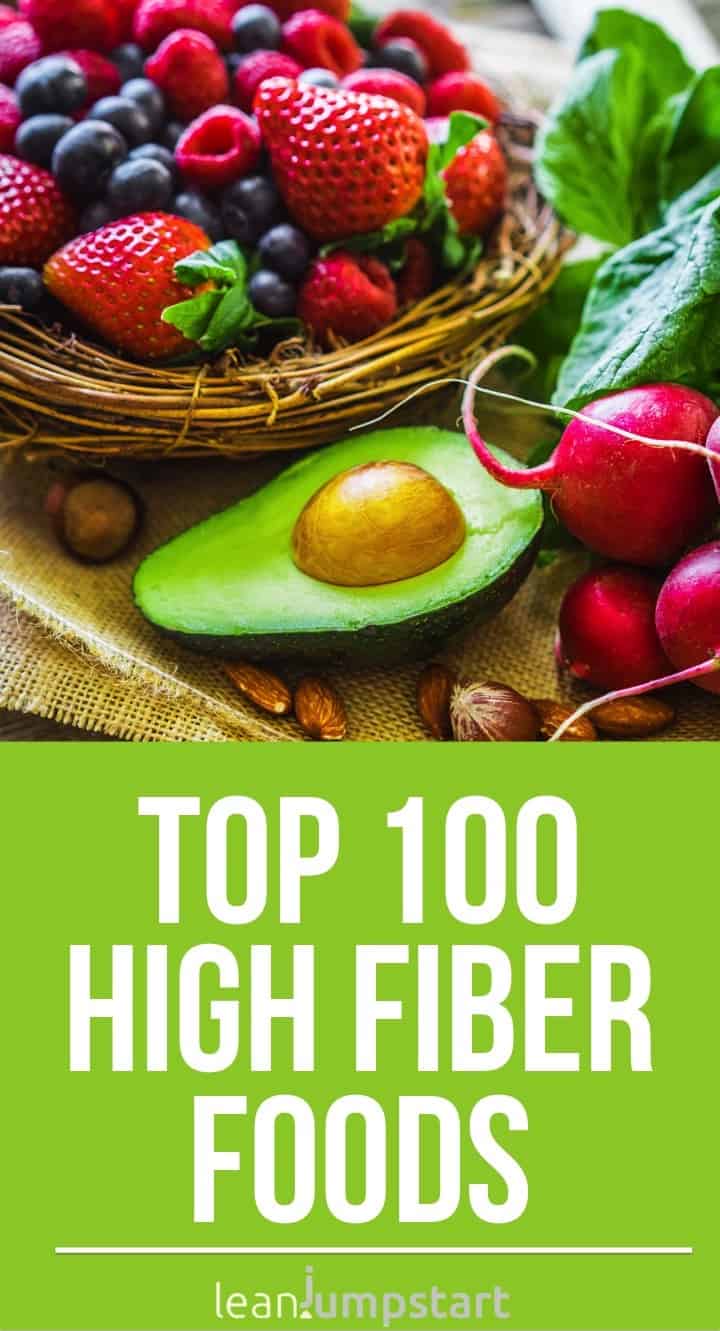
An important cornerstone of a complete and balanced nutrition
I have already written about fibrous foods in many of my blog posts focusing on clean eating and good habits. A typical example is my article “3 simple steps to eat more whole grains“. I have found that a fiber-rich diet can be helpful with aid in energy intake control.
But, what are dietary fibers? What are the different types and what benefits do they provide? Hint: There are more than you might expect. How much of this precious nutrient should you eat per day to support your digestive system and foster good gut bacteria?
In this blog post, I’ll dig deeper into this important topic. With the help of various food charts, you can easily see which groceries you should focus.
What is fiber?
The American Association of Cereal Chemists (AACC) classifies dietary fiber as “edible parts of plants or analogous carbohydrates”. Those plant parts are resistant to resorption and digestion in the human small intestine but are partially or fully decomposed in the colon”.
In a shorter definition, I consider them as fibrous components found in cell wands of all plant-based foods made of complex carbohydrates. They do not occur in animal products. For the most part, these are linked sugar molecules that the small intestine cannot digest or is unable to digest adequately.
Soluble vs insoluble fiber
A basic distinction is made between two different types: the soluble and insoluble fibers. Both groups have different characteristics.
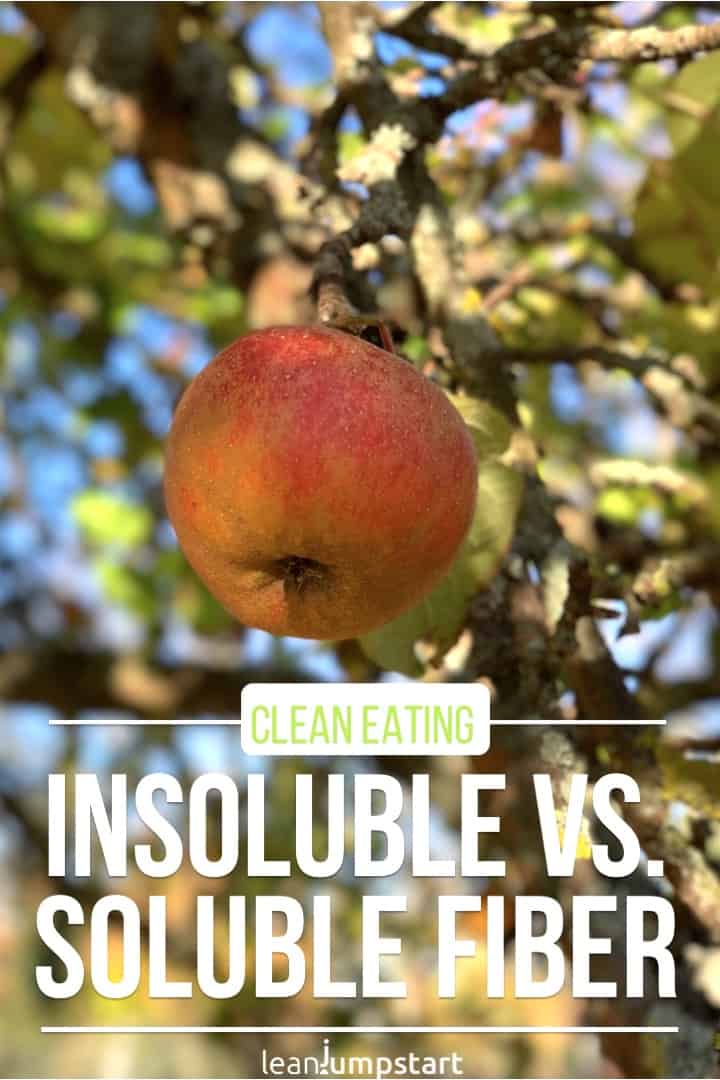
- The soluble ones act as natural gelling agents and are often associated with the pulp or flesh of foods. They include, for example, pectin (the same “pectin” found in jellies and jams), inulin and beta-glucans.
- Cellulose and lignin belong to the insoluble dietary fibers and derive from a plant’s tough, outer skin.
Soluble fiber foods
The advantage of produce high in soluble food ingredients is that they absorb liquid in our bowels, expand and turn to gel. This gives our gut microbiome something to do. In consequence, we experience a longer lasting feeling of satiety.
That’s also the reason why it’s easier to lose weight with this kind of foods. You’ll find in the “soluble list” mainly beans, nuts, berries and various grains such as oats and barley. They also bind toxins and other harmful substances that enter the intestines with edibles and thus promote their elimination.
Insoluble fiber foods
This insoluble food ingredient (the typical roughage) acts like a “natural bulking agent”. It is found mainly in vegetables, fruits, most whole grains, most beans, brans and flax seeds. Even if these agents have no direct effect, they help our digestive system organs by their pure presence. That’s because they increase stool mass and move content through the colon.
As you can see much nutritious produce like fruits, vegetables or legumes contain a mixture of soluble and insoluble fiber. Regardless of whether they act as natural gelling or stool bulking agents, dietary fiber is good for our health. Let’s take a closer look.
Top 5 health benefits of fiber
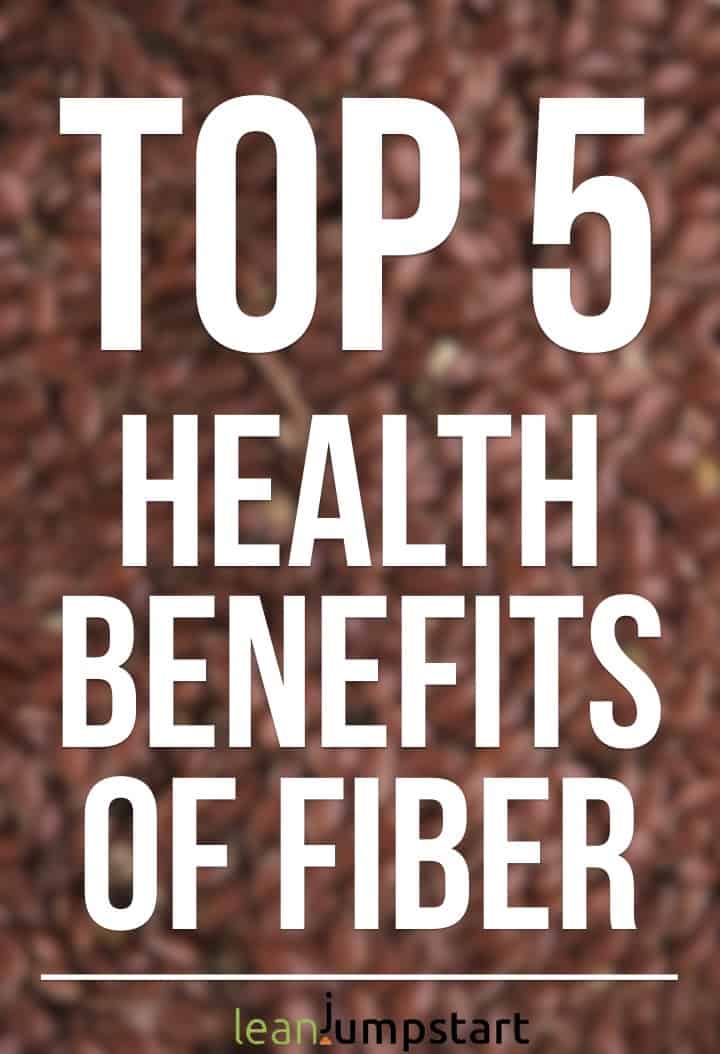
When physicians first discovered dietary roughage, they thought it was useless and just a bulk or “ballast” for our body. That’s why here in Germany we still call this fibrous component “Ballaststoff”. Today, however, the diverse health benefits of these natural laxatives are well researched.
1. Supports weight management
In metabolic diseases such as obesity, a high bulk diet can be very beneficial (2). Although the fibrous compounds practically do not leave the gastrointestinal tract in the direction of blood, they have far-reaching effects. Already in the stomach, they thicken the food porridge, delaying the emptying of the stomach and thus making it fuller for longer.
So, if weight control is your goal, you can take advantage of the satiating effect by eating groceries with lots of roughage. Feeling full get’s much easier, when you increase the daily amount of fiber.
2. Decreases risk for type-2 diabetes
Dietary roughage leads to a slower rise in blood sugar levels after eating and less insulin is released. This can be beneficial for people with type-2 diabetes. A roughage diet, especially with cereal fiber also reduces the risk of developing diabetes.
If you want to dig deeper, I highly recommend reading the results of the world’s largest diabetes study published in Diabetologia. (3)
3. Promotes digestion & well-being
Since our bowel is also the center of our body, it plays an essential role in our health. While the small intestine breaks down already fats or proteins, soluble fibers pass through this area without any damage.
It is only in the colon that this prebiotics fuel our intestinal bacteria to produce short-chain fatty acids, regulating the appetite control and immune system. That way the soluble food ingredient serves the gut flora as food and keeps gut bacteria from fermenting the colon’s lining (4). This leads to an increase of gut microbes, which in the end, benefits the intestinal health.
The insoluble, stool bulking agents are hardly broken down in the intestinal tract. They serve, as mentioned, purely for the onward transport of edibles, which accelerates the excretions.
Sidenote
Have you ever wondered why eating just a pear or some blueberries for breakfast promotes your digestion? Well, you can thank the fabulous fibrous fruits. Increasing the bowel volume stimulates also the intestinal movements. Thus, both insoluble and soluble fibers have a positive effect on our digestive system and well-being.
4. Prevents colon cancer
Bulk rich nutrition has also a positive effect on a whole range of gastrointestinal diseases. This starts with constipation and ends with more serious illnesses such as colon cancer. A major review study associates a fiber-rich diet with a lower risk of colon cancer. (5)
5. Protects against chronic diseases & lowers mortality rates
Last but not least, it is supposed to prevent arteriosclerosis, heart attacks or high blood pressure as well as other cardiovascular diseases. (6) All of these positive effects have prompted researchers at Harvard University to conduct a major review study on dietary fiber.
They found that the mortality rate of more than 700,000 study participants decreased significantly the more of these desirable food substances they consumed daily. Anyone who ate at least 70 grams of whole grain every day, had even a 20 percent lower risk of dying from cardiovascular disease such as stroke or cancer.
Top 5 high-fiber foods lists
The important question is what foods are high in fiber? A good source is legumes, grains, cereals, fruits, and vegetables.
In the following charts, I have put together the best foods in different food categories. As an avid clean eater, hopefully, many of those wholesome foods are already an integral part of your diet.
1. Cereals, grains, and pasta:
Whole grains are complex carbohydrates with lots of natural bulk forming agents. Most of the fibrous compounds are in the outer layers of the grains. The following list gives you an overview of the most common fiber heavy cereals, grains, and whole wheat pasta. Many people will love to see the air-popped popcorn ranking at the top, only beaten by bran flakes.
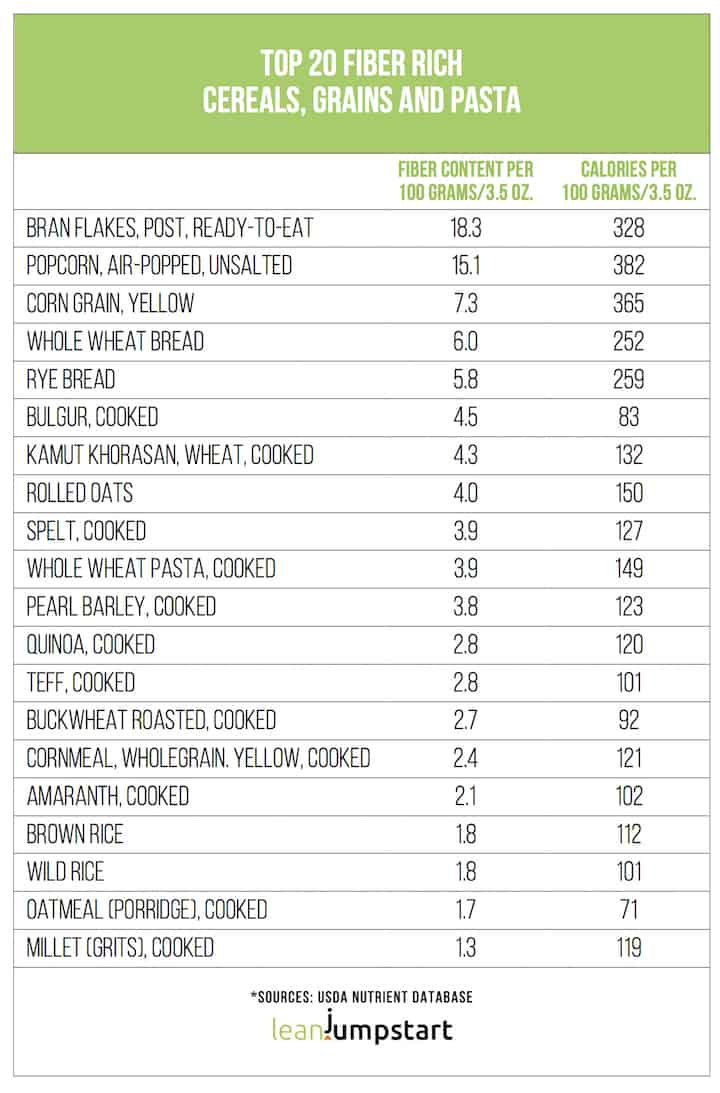
Read also:
- How to identify whole grain foods
- My favorite homemade whole wheat bread recipe
2. Vegetables and salad
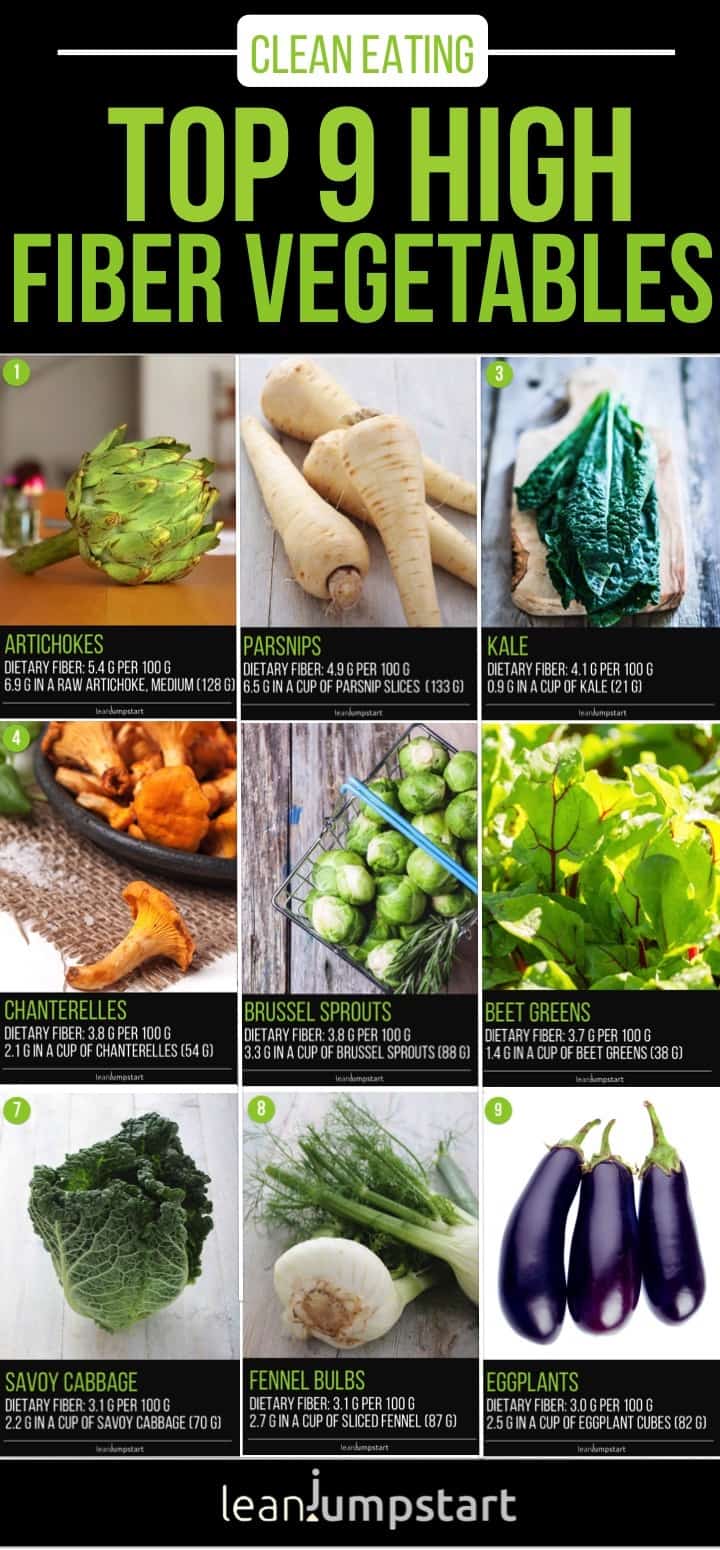
These nutrient-dense groceries do not have as much “ballast” as cereals, at first glance. But look at the ratio! Vegetables provide per 100 kcal the most roughage. In the table below, for example, you can immediately see that especially greens perform best per 100 kcal. It might be time to look for beet greens or turnip greens at your next grocery shopping.
But you can spot in this category even more high-fiber low-calorie foods such as cabbage, chanterelle mushrooms, and endive.
Click through for the Top 30 high fiber vegetables.
In addition, most vegetables provide vitamins, minerals and valuable secondary plant substances like sweet potatoes or eggplants. It is no longer a secret that you should always eat enough of them. Especially when weight loss is your goal, fibrous vegetables can help you effectively fight hunger feelings. The following list gives you an overview:
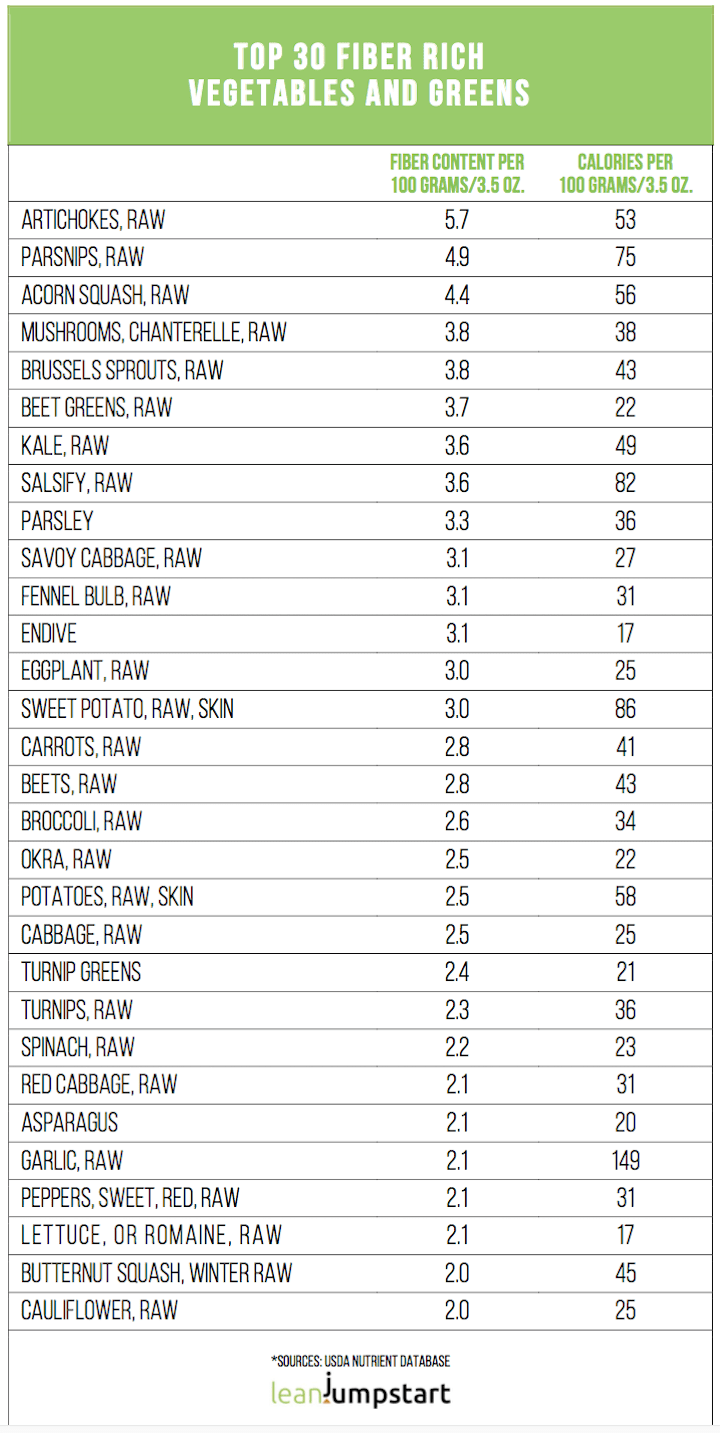
3. Legumes
The absolute classics among the high roughage foods are, of course, legumes that often provide high amounts of roughage per 100 grams. Yet, calculated per 100 kcal, fruits and veggies, perform much better.
On the other hand, pulses are protein-rich and count to the world’s cheapest sources of quality nutrition. Red, uncooked lentils contain more protein than the same quantity of meat.
All in all, Americans (but also Europeans) clearly don’t eat enough in this food category. It’s easy to turn your nutrition into a high-fiber diet when you eat legumes on a regular basis. Great options are black beans, split peas, lentils, chickpeas or lima beans. Take a closer look at the following list.
A flavorful recipe full of different legumes you can find here: cowboy caviar recipe
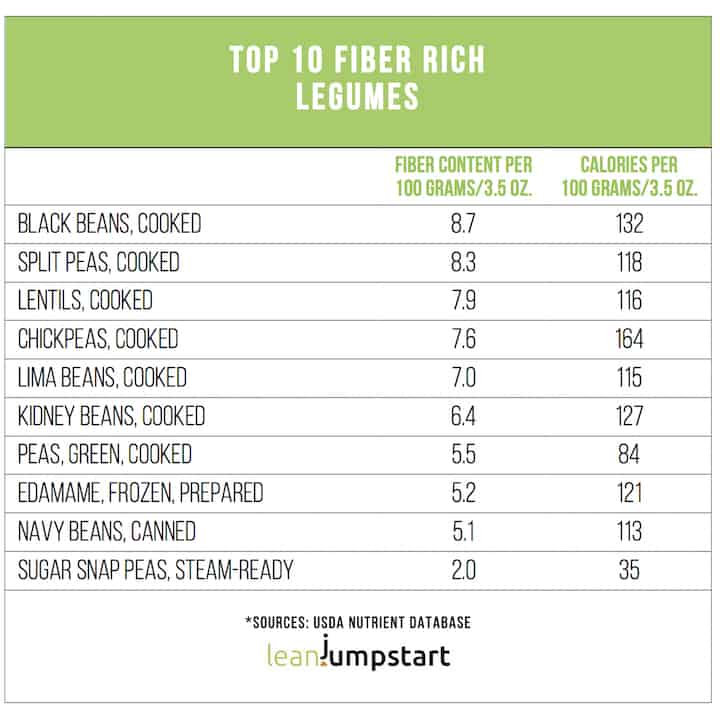
4. Fruits (including dried fruits)
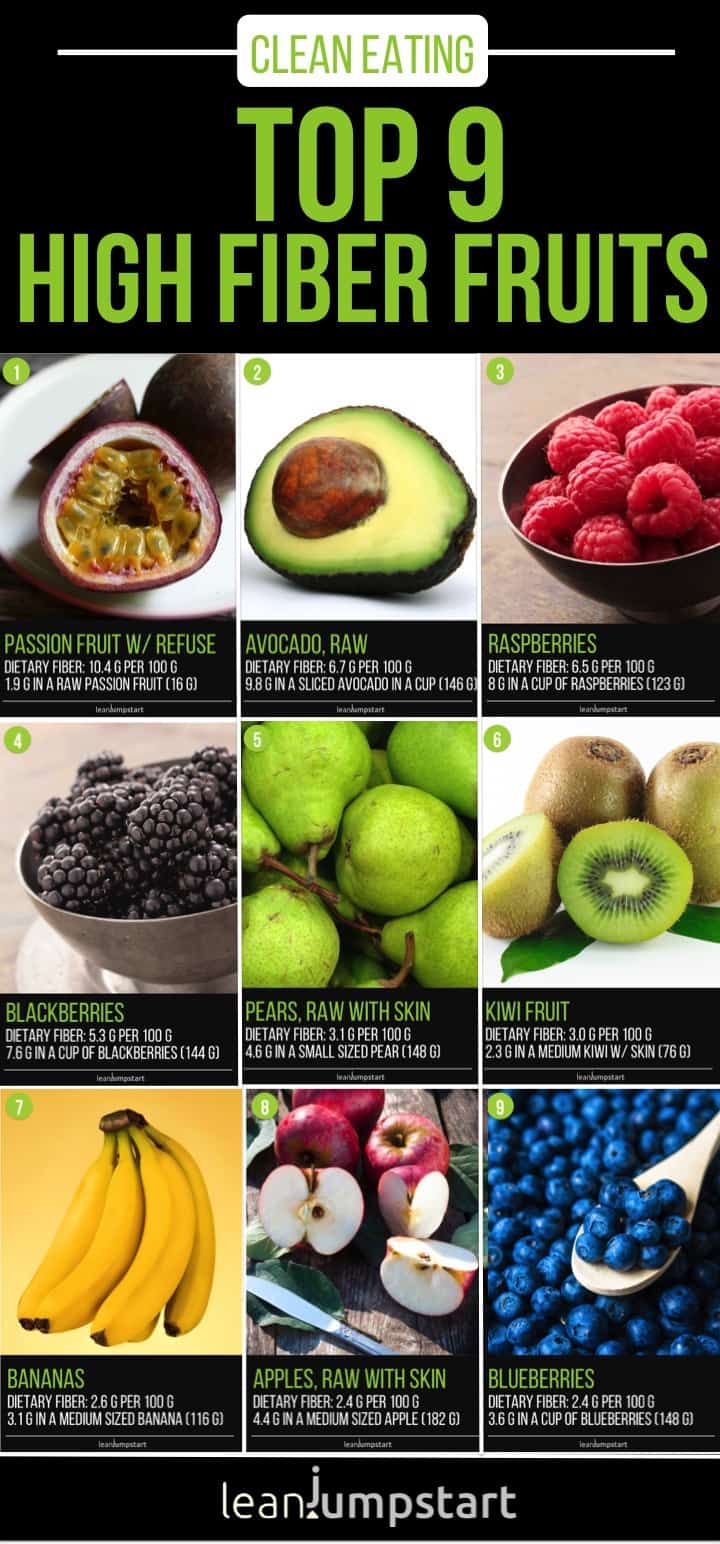
Dried fruits like dates, apricots, and plums (prunes) rank at the top of the fruit list and are known as natural laxatives. Fresh raspberries, blackberries, and pears are also great sources of fiber. These vitamin bombs are also a great ingredient to kick-start your day. Read in this context also my 5 tips for a high-fiber breakfast.
The unbeaten fruit with most of the desired substance in the following list is the passion fruit. If this exotic food with a still moderate calorie content is affordable in your region, make sure to grab it! Check in this context also my list of Top 26 fruits with fiber.
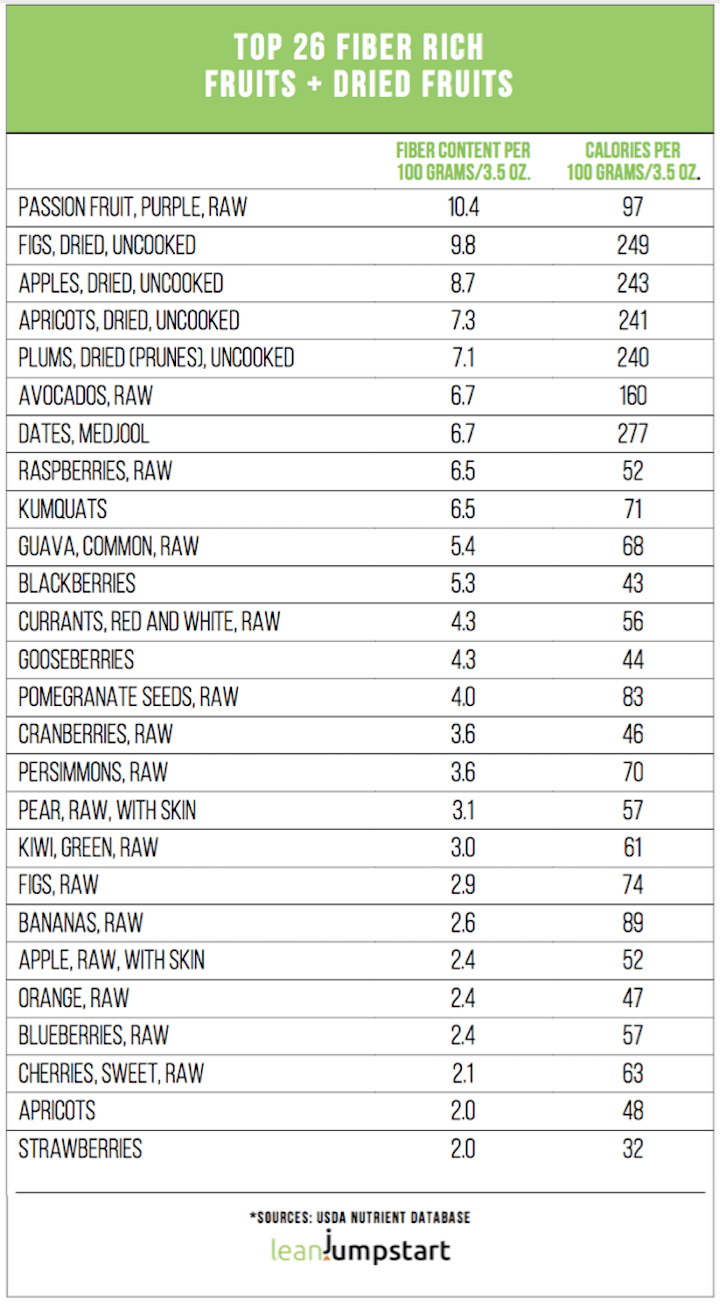
5. Nuts and seeds
In this last food category, you’ll find groceries with the most roughage per 100 grams. Especially nuts are a perfect nutritious snack on the go. Check in this context also my list of top 11 high-fiber snacks.
But nuts and seeds contain often also plenty of healthy fats and therefore many calories. In consequence, moderation is key when weight loss is your goal. Especially almonds and walnuts have a very good fatty acid profile and are highly recommended in two respects. They cover the dietary fiber requirements and they are also perfect to ingest the valuable mono- and polyunsaturated fatty acids.
Particularly noteworthy are the highly nutritious chia seeds and flax seeds which are ranking highest on the list below. Click through for the top 30 chia seed breakfast pudding ideas. If prepared correctly they can be successfully used as natural laxatives to stay regular.

Are eggs high in fiber?
Eggs are high in sodium, cholesterol and fat, but low in fiber. But you can add chopped veggies, like broccoli, avocado, or spinach. You can also serve eggs with whole wheat bread, muffin, or a slice of toast.
How much fiber a day is recommended?
The Institute of Medicine recommends:
- women: at least 21 to 25 grams of fiber a day
- men: at least 30 to 38 grams a day
This is consistent with the advice of the American Heart Association. The United States Department of Agriculture (USDA) recommends for women a daily fiber intake of 28 grams.
Why animal-based products are a challenge
Unfortunately, less than 3% of Americans meet the recommended intake. The reason why we eat far too little of it is usually, that neither meat nor dairy products contain any dietary roughage. Fact is, the average American eats far too much of animal-based products.
By the way, in Germany, an average of 30 grams a day is recommended by the “Deutsche Gesellschaft für Ernährung (DGE)”. The DGE is an independent German nutrition association.
70 grams a day for best stroke protection
When it comes to daily recommended fiber content, Dr. Michael Greger from nutrition.org goes a great deal further: “If you really don’t want a stroke, we should try to get 25 grams a day of soluble fiber (found concentrated in oats, beans, nuts, and berries) and 47 grams a day of insoluble fiber (roughage concentrated in whole grains)”(6).
Let’s do the math!
Dr. Michael Greger’s suggestion is to consume in total over 70 grams of fiber a day for best heart disease and stroke protection. I know that this number seems like a serious stretch…But did you know that our early ancestors ate on average 75 grams per day and, sometimes, even more? This meant they were eating a diet largely consisting of low-calorie, low-energy foods which helped control the appetite.
So if best possible stroke protection is your goal, then trying to focus your nutrition around foods, leading the here presented ranking lists, might be a good idea.
Why you should increase your intake slowly?
If you have previously eaten very little bulk and now increase your intake, your body may initially react with flatulence, bloating, and grumbling intestines. The human digestive system must first get used to this diet change. It’s best to gradually increase the consumption and to chew a lot to avoid the initial digestion issues.
The symptoms often disappear over time. Some people, however, do not tolerate all foods or only a certain type and/or amount of them. In this case, it is important to check individual tolerance.
Do you have a sensitive gut?
If the intestine is sensitive at first, you should use legumes, onions, and cabbage sparingly. Prefer to serve other vegetables like carrots or parsnips. Instead of coarse-grained whole grain bread, I recommend finely ground or mixed rye bread. It contains three times more fiber per serving than white bread.
In the following, I’ve put the 30 best foods (Top 6 per category) in a chart. To maximize your intake throughout the day, make sure to consume plenty of the following fiber-heavy foods.
Does fiber relieve or cause constipation?
Eating fiber can relieve constipation. Fiber is a form of carbohydrate that is not broken down in the small intestine. Fiber helps prevent constipation because of its ability to promote movement of the large intestine. Be sure to drink plenty of water to help your body process fiber.

Additional lists & charts you might enjoy
- Eatthis.com has put together a list of 43 fibrous foods. They provide 10%-19% of your DV which is equivalent to between 2.8 and 5.5 grams of fiber per standard portion size. Click here!
- Draxe.com focuses on lesser-known food stars that are not only fiber heavy, but also contain essential nutrients. Learn more by clicking here!
- Greatist.com pairs the 16 most surprising roughage foods with a delicious go-to recipe each. Grab the recipes here!
Why you should level up your hydration?
Be aware, however, that the more fiber your nutrition contains, the more liquid you need in the process of digestion. As gelling agents swell in the gut, water is withdrawn from your body, which you have to return again.
Consequently, if you switch to a roughage diet, you should also significantly increase your water consumption. Proper hydration doesn’t do any harm anyway, because many people usually consume too little liquid.
How to start safe and easy?
In the beginning, I recommend concentrating on fruits and vegetables from the lists above. That’s also the focus of the first few weeks in my 52 Chef Habits E-course. In my flagship program, I help course students to develop good habits that stick.
Fruits and vegetables do not only contain dietary bulk, but also a lot of liquid! Muesli with nuts and fruits or a breakfast smoothie will start your day with a good dietary fiber source. Vegetable soups are another great option. These meals are easily digestible and contain in addition also a lot of liquid.
Take it to the next level with whole grain foods
If you want to take it to the next level, you can easily replace foods you love with the whole grain version. This goes particularly well with brown rice, whole wheat bread, and whole grain pasta. Don’t give up with the first type of whole grain food. Take your time to test out several whole-meal products until you find your favorites.
Best supplements
The best roughage comes of course from real foods as presented above. If you can’t tolerate them, you can also buy supplements. Wheat bran, guar gum, pectin, or agar-agar is the best fiber supplement you can get. Such a dietary helper is available either as a powder or in the form of tablets and granules.
From a medical point of view, the supplements can make sense in case of constipation. The nutritional supplements are, however, much more expensive than high fiber diet foods.
Also, the added value of the disease-fighting nutrients and phytochemicals we get from fruits, vegetables, and other whole foods is lost. Therefore, it’s always better to use food in its natural form.
Simple recipes for weight loss and a heart-healthy way of eating
It is no coincidence that many plant-inspired recipes you find in my E-course and on my blog are easy meals with lots of roughage. Click through for my 10 best fiber meals. I love to cook with whole grains, vegetables, fruits, and legumes. Hey, there are even some banana oat cookies waiting for you:)
Bottom line:
A high-fiber diet plan, that effectively supports your digestive system functions is key for successful weight management. It is also a sustainable approach to prevent or reverse those typical chronical diseases of the modern world.

What a great article! I am very much into high fiber diet. I love how you lay it all down. I’ll be referencing your post often. Amazing job!
Thank you for you kind words Edyta. Sharing and referencing my article is highly appreciated:)
Fibrous foods are great to include in diet. And so tasty too. Just people have to bring it back into the diet and palate.
That’s true Roxana. Hopefully my charts can inspire many people to increase their fiber consumption.
Thanks for sharing these fiber strong options – I am always trying to add more fiber to my diet!
You are very welcome Jaclyn. Just make sure to drink also sufficient water:)
Great list! Fiber is so important! Thanks for sharing 🙂
That’s true, Jamielyn. You are so welcome:)
This is such a helpful post for people looking to increase their fibre intake. Fibre is so important!
Thank you Danielle, I’m glad that you’ve found my post helpful:)
sorry for the confusion. Glad to post a nice comment for this since I am so into Keto and healthy foods. Fiber for one, I love the useful information in this post thank you so much I am going to be bookmarking this one!
No problem, Claudia, you are very welcome. Wishing you all the best for your Keto & healthy foods journey:)
I became aware of all the great fiber benefits when my Mom got diabetes!
Yes, eating sufficient fiber can be especially helpful for those with diabetes. One of the main goals for those with diabetes is to lower blood glucose levels. That’s exactly what fiber does among other health benefits.
So much information, and helpful to have them listed in different categories.
Wow this post is loaded with information on fiber! We are definitely trying to increase our fiber so this is an amazing resource! Pinned!
Thank you Pam, it’s much easier to increase fiber when you know which foods are especially rich in fiber. E.g. I was very surprised to see passion fruits ranking number 1 on the fruit list.
What an amazing resource. I am bookmarking this page for reference.
You are welcome, Sandi.